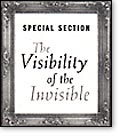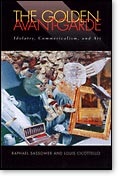David Morgan
The Visibility of the Invisible: Art and Idolatry

Special Section

The Golden Avant-Garde
The Golden Avant-Garde: Idolatry, Commercialism, and Art, by Raphael Sassower and Louis Cicotello, University Press of Virginia, 147 pp.; $17.50, paper
The central conceit of this book, signaled in the "golden" quality of the "avant-garde" as well as first word of the subtitle, is the golden calf wrought by Israel as Moses tarried on Sinai in the presence of the mysterious and terrible Jahweh. Down below, left to themselves, consumed in the ordinary, the people wanted Aaron to fashion an idol to replace the vanished leader and his God.
In the biblical telling, of course, this act of idolatry is condemned and punished, but Raphael Sassower (a philosopher) and Louis Cicotello (an artist) had a different moral in mind when they appropriated the story. In our time, Sassower and Cicotello say, "we have lost our trust in religious institutions as a means to a spiritual end," and hence "we desperately need art, among other cultural expressions," to take the place of religion—to produce golden calves, as it were, offering "alternative means through which to reach our spiritual destiny."
In short, Sassower and Cicotello are all for idolatry—but not just any idolatry will do. They want to persuade readers to reject the naïve form of idolatry inscribed in the myth of the avant-garde and the cult of the genius, illusions in which artists and their public are complicit. The purpose of art is not redemption. The artist has no magic wand, is neither a glorious savior nor a gloomy prophet with divine law in hand. None of that works anymore. Instead, the authors call for an ironic, disenchanted form of idolatry.
Sassower and Cicotello are at their most persuasive in undercutting the pretensions of the avant-garde. This is a French term meaning "advance guard," originally a military movement of mounted soldiers who charge the opposing infantry in order to break a hole through which their own rank-and-file infantry can follow. In the early nineteenth century, the term was applied to artists by Henri de Saint-Simon, a utopian thinker and proponent of Enlightenment. Saint-Simon announced that universal progress lay in the hands of artists and intellectuals, who could provide the cultural inspiration and leadership toward social improvement and cultural refinement.
Avant-garde art has been defined in many and often conflicting ways since then—sometimes in terms of the romantic cult of genius, at other times as the work of bohemians who delight in bad-mouthing bourgeois respectability, and on still other occasions as the revolutionary efforts of radical (Marxist or anarchist) artists from Gustave Courbet to the surrealist André Breton. Today it often means little more than this month's enfant terrible, who has snatched artworld headlines for having done something outlandish like mutilating his genitals or exhibiting a cow's carcass in formaldehyde.
Sassower and Cicotello happily wish to recover a constructive use of the term. They expose the sleight of hand whereby the avant-garde artist is magically extracted from the commercial reality of capitalism and the marketplace. If the bohemian and the radical artist were supposed to have transcended market forces by boldly dismissing state and church patronage, nevertheless their work was commissioned, purchased, and collected by the wealthy and by museums. Art dealers intermediated artists (who came to create their work on speculation and place it on consignment in galleries) and the "public," which consisted of growing numbers of patrons who acquired works of art for the love of collecting, but also, increasingly, for the purpose of investment and eventual resale. Sassower and Cicotello are prudently critical of any version of the avant-garde which refuses to recognize that artists are "fully enmeshed in the overwhelming powers of the culture of capitalism."
Indeed, the authors flatly deny that art can deliver modern life from the "corruption of capitalism, modern politics, and mass communication." Each of these potential enemies of freedom has been targeted by prominent theorists of the avant-garde such as Theodor Adorno and Clement Greenberg. Sassower and Cicotello reject their accounts as well as a host of others.
What then is the avant-garde to do? If the artist is not Moses interceding with the Lord on humanity's behalf or bearing divine revelation, Sassower and Cicotello nevertheless believe that art can "confront the ambiguities of modernity (now in its postmodern guise), critically engage them, and whenever possible provide troubling images with which to meet public expectations." This sounds rather modest, but at least it is doable. Artists, the authors contend, are in the consciousness-raising business. They call conventions into question, not by perching above the social flux—that's an illusion fostered by "geniuses" and their acolytes—but by pointing to the contradictions and ambivalences in modern life. As the authors put it, instead of presuming to transcend commerce, the avant-gardist should "acknowledge the predicament, embrace its thorny crown, carry its cross, and undermine its ugly underbelly whenever you can."
But this rhetorical riff cuts against the authors' acceptance of the secularization thesis. They endorse the notion that institutional religion has disappeared, like Moses on Sinai. In the scheme of the book's argument, avant-garde artists don't serve as Jesus or Moses, but as Aaron. What Aaron offered was not a prophetic critique of the unexamined desire for a socially constructed god but rather a willing indulgence of that very desire.
Can't artists rise above the conventional for moments of sequestered intercourse with the divine and then return? Sassower and Cicotello do not believe so. Artists are stuck "here" like everyone else. All they can do is offer some reflection on the irony of it all. But that's worth something, because it opens a space with in the mind-numbing world of earning and spending, within the daily routines of consumption that lull us to sleep. We may not be able to transcend our situation, to pull ourselves out by our own bootstraps. But we can defy the urge to submit wholeheartedly. We can resist the banal smile and opiating effects of advertising, even as we are pulled along by the irresistible currents of global capital.
Yet one wonders why art and religion must be opposed to one another—why must one replace the other? Why can't art and religion work in concert with each other as prophetic forces? Why can't a faithful and mutually sympathetic voice of protest be sounded in each activity? And why can't the artist be a believer, and vice versa? When art and belief do coincide in the person of an artist such as Yves Klein, the authors suggest, that belief is an ironic gesture: "Klein prays for hope and redemption in his own romantic, quasi-religious manner."
In a 1959 performance piece called Ritual for the Relinquishing of Immaterial Zones of Pictorial Sensibility, Klein exchanged a designated portion of space above the city of Paris for quantities of gold. Half of the gold which Klein received he gave to the shrine of his patron saint, Rita of Cascia. In so doing, Klein linked the modern economic circumstances of creating and selling art to the medieval economy of the cult of the saints, wherein believers acquired saintly intercession through pious acts of penance or dedication. While Sassower and Cicotello liken Klein's work to the golden calf of Aaron, Roman Catholic piety sees in devotion to the saints active faith in the God whom Moses served. In other words, Klein may resist the incursion of capitalism by grounding his work in an older economic relation, which does not deny capitalism but integrates it into a spiritual economy.
Art and belief may not cooperate in avant-garde ventures if one adopts the secularism of Sassower and Cicotello. In their view, the age of belief is over. All one can do is find a substitute for lost faith. Moses is gone; long live the golden contraptions here below. But if, for example, avant-garde artists have it within their limited power to alert us in compelling ways to the delusion that owning and consuming are the basis of happiness, and if prophetic religion can do the same by proclaiming that sharing is better than hoarding, that giving exceeds receiving, don't the two, art and belief, have something powerful in common here and now?
David Morgan is Associate Professor of Art at Valparaiso University and author of Visual Piety: A History and Theory of Popular Religious Images (Univ. of California Press) and Protestants and Pictures: Religion, Visual Culture, and the Age of American Mass Production (Oxford Univ. Press). With Salley Promey, he is the editor of The Visual Culture of American Religions, forthcoming in May from the University of California Press.
NOTE: For your convenience, the following product, which was mentioned above, is available for purchase:
• The Golden Avant-Garde, Raphael Sassower and Louis Cicotello
Copyright © 2001 by the author or Christianity Today/Books & Culture Magazine.
Click here for reprint information on Books & Culture.








Displaying 0–0 of 0 comments.
Displaying 0–0 of 0 comments.
*